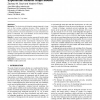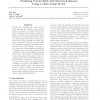158 search results - page 1 / 32 » Exploring biological network structure using exponential ran... |
BIOINFORMATICS
2007
14 years 6 months ago
2007
Motivation: The functioning of biological networks depends in large part on their complex underlying structure. When studying their systemic nature many modeling approaches focus ...
FOCS
2008
IEEE
15 years 27 days ago
2008
IEEE
A plethora of random graph models have been developed in recent years to study a range of problems on networks, driven by the wide availability of data from many social, telecommu...
BMCBI
2010
14 years 6 months ago
2010
Background: We present a statistical method of analysis of biological networks based on the exponential random graph model, namely p2-model, as opposed to previous descriptive app...
CORR
2011
Springer
14 years 1 months ago
2011
Springer
Dynamic graphs have emerged as an appropriate model to capture the changing nature of many modern networks, such as peer-to-peer overlays and mobile ad hoc networks. Most of the re...
ICML
2005
IEEE
15 years 7 months ago
2005
IEEE
Protein fold recognition is a key step towards inferring the tertiary structures from amino-acid sequences. Complex folds such as those consisting of interacting structural repeat...



